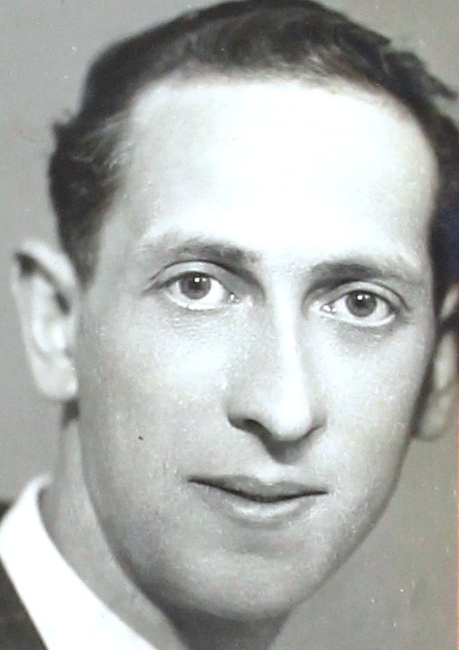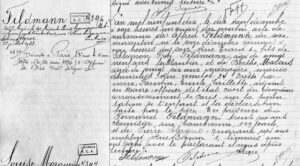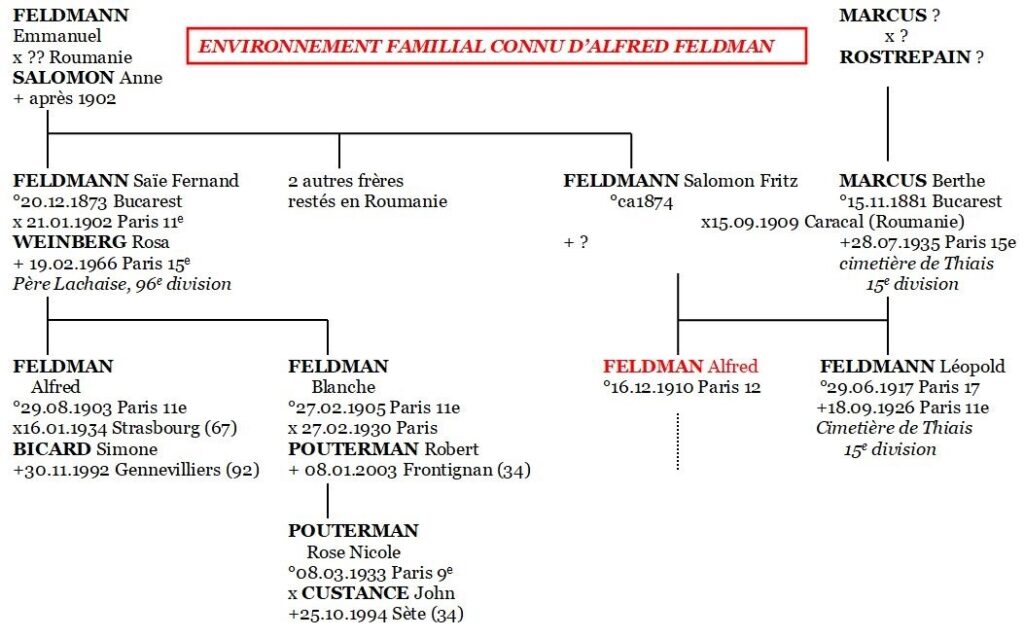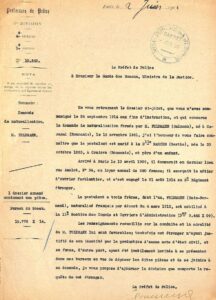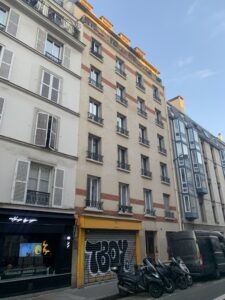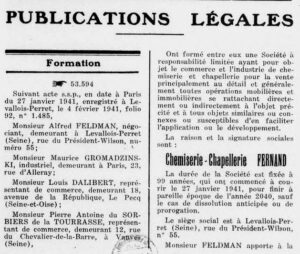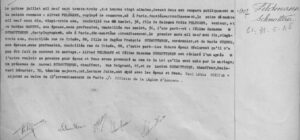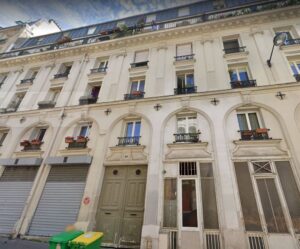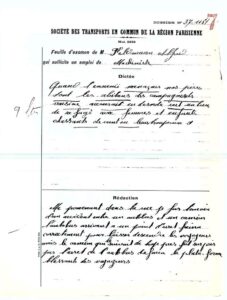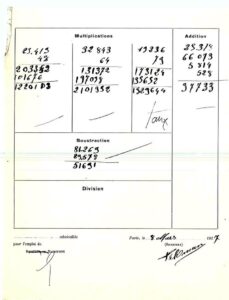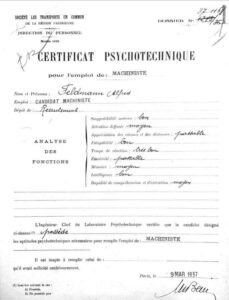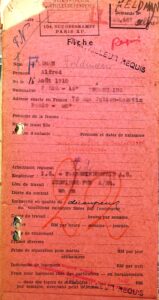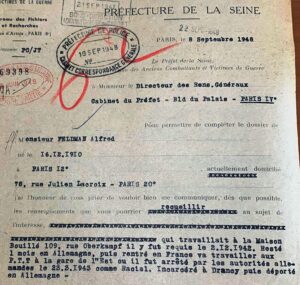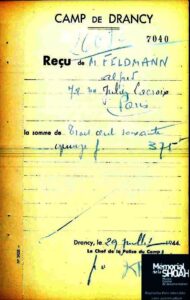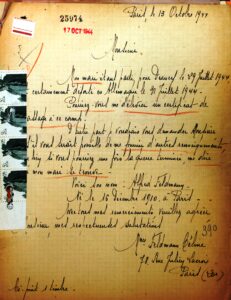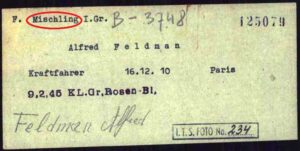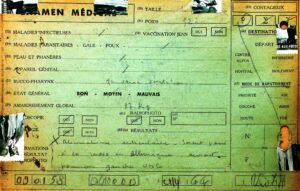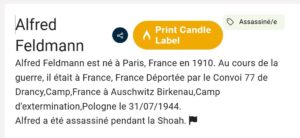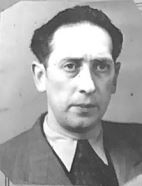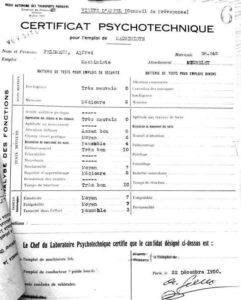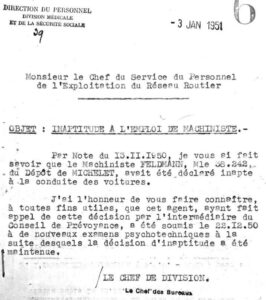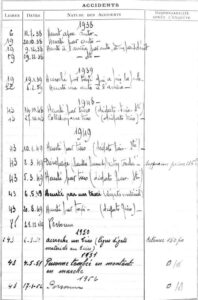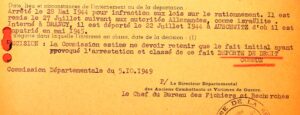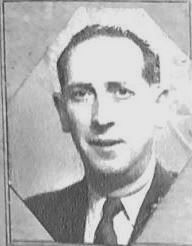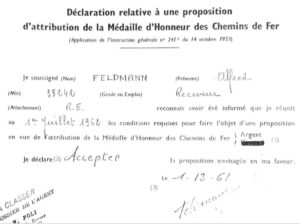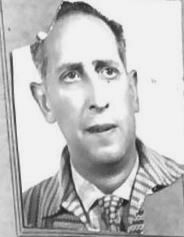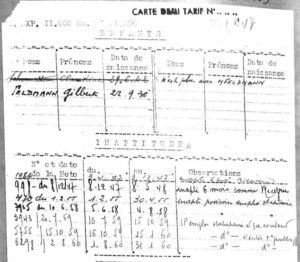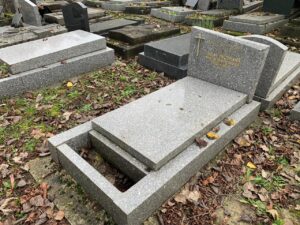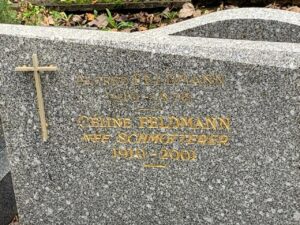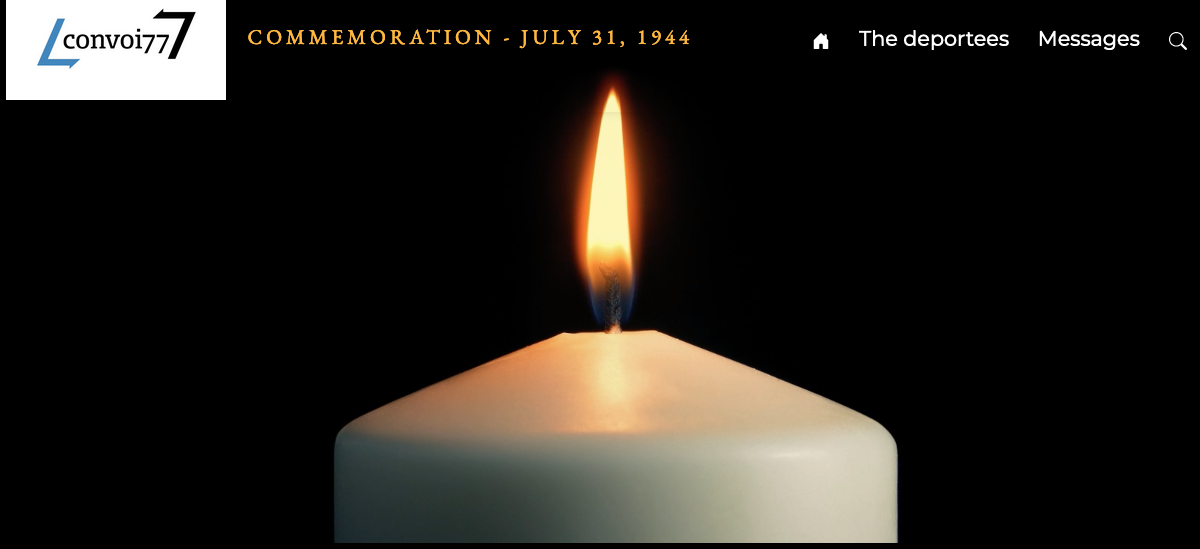Alfred FELDMANN
This project was carried out by a class of 12th grade students at the Maurice Ravel high school in the 20th district of Paris, France, during the 2023-24 school year, under the guidance of their history teacher and homeroom teacher, Philippe Landru. Comprising some thirty students, the class split into three groups to work on three different biographies as part of the Convoy 77 project. Ten students worked on this biography of Alfred Feldman. This year-long assignment was also their ethics and civic education project, which was assessed as part of their French baccalaureate exams
INTRODUCTION
When we began working on Alfred Feldman’s biography, we made contact with two of his descendants, Jeanne and Marie Parrinet. Jeanne kindly shared with us some additional and valuable information about Alfred’s professional life, her family having already done some research into his background. Unfortunately, there was very little to go on: although Jeanne and Marie’s grandfather is reputed to be Alfred Feldman’s son, this is based solely on his own assertion. As we shall see later, there is no other evidence of this relationship in any of the official records we have on Alfred Feldmann. His son is still alive, but is now a very old man, and was profoundly affected by a difficult and traumatic childhood. The Parrinet family is therefore unable to question him in order to glean any memories he may have of his parents: a frustrating yet all too common scenario.
Although we have managed to solve a few mysteries about his family background and his life story, there are still many grey areas. Looking ahead to any future research, be it by family members or academics, we conclude this biography with an overview of the unsolved mysteries, along with a few potential leads.
I ALFRED FELDMAN’S FAMILY BACKGROUND
Although he was born in 1910 in Paris, Alfred Feldman came from a Romanian background.
A. His parents and his brother
Alfred Feldman, who was born on December 16, 1910, was the son of Salomon Fritz Feldmann[1] and Berthe Marcus.
Alfred Feldman’s birth certificate, dated December 19, 1910, in the 12th district of Paris.
Paris civil status register (online)Unfortunately, we have little information about his ancestors: Salomon Fritz Feldmann was born on November 15, 1881 in Caracal, in what was then Wallachia. He was the son of Emmanuel Feldmann, who died sometime prior to 1902, and Anna Salomon, who was still alive and living in Bucharest in 1902. We know from his application for French citizenship that he married Berthe Marcus on September 15, 1909 in Caracal, Romania. Berthe was born on February 25, 1882 in Bucharest[2]. We do not know her father’s name, and her mother is only listed under the surname Roscutipain (or Rostrepain), a surname that seemingly does not exist, so probably reflects a failure to understand the name she gave at the registry office in Paris. The couple moved to France soon after they were married[3].
In his application for French citizenship, there are a few details about Salomon’s physical appearance: he stood 5’5” tall, had blue eyes and an oval face. From 1903 to 1906, he did his national service in the 4th Infantry Regiment in Pitești, Romania.
In France, on August 5, 1914, a law was passed that enabled “the government to naturalize, with no residency requirement, foreigners who sign up for the duration of the war”. Salomon joined the French Foreign Legion on August 21 (service number 24,520). He fought in the First World War, and was wounded by gunfire to the abdomen and knee on July 5, 1916, in Belloy-en-Santerre during the Battle of the Somme[4]. As a result, he was commended in the Order of the Regiment, awarded the French War Cross and granted a war pension due to being 15% disabled.
In 1915, Salomon and his wife applied to be naturalized as French citizens, but because they were unable to provide their Romanian birth and marriage certificates, the application was put on hold.
In 1925, they reapplied: by that time they were living at 34 rue Amelot, in the 11th district of Paris. Salomon was working as a tinsmith, earning around 30 francs a day and paying 520 francs a year in rent. This time, they were granted French nationality, as confirmed in an announcement in the French Official Gazette on March 28, 1927.
1: A page from Salomon’s application for French citizenship, French National Archives, ref. BB_11_6137_16778X14
2: 34, rue Amelot, 11th district of Paris. Our own photo
Léopold Armand Feldmann (who is also listed as Paul in some records), Salomon’s second son and Alfred’s brother, was born in the Rothschild Hospital in Paris on June 29, 1917. He died on September 18, 1926 at his parents’ home on rue Amelot. He was initially buried in the Pantin cemetery in Paris but on October 7, 1936 his remains were transferred to his mother’s grave in the Thiais cemetery in Paris.
At some point between 1933 and 1935, although we do not know exactly when, Salomon and his family left their home on rue Amelot and moved to 109 rue Cambronne. This was the address listed for Berthe Marcus when she died in the Necker Hospital in Paris on July 28, 1935[5]. She was buried in the 15th division of the Thiais cemetery[6], to which, the following year, as we have already mentioned, the remains of her son were subsequently transferred.
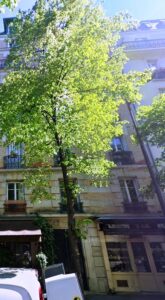
109, rue Cambronne,
Our own photo
Berthe Marcus’s death certificate, dated July 21, 1935, in the 15th district of Paris.
Paris civil status register (online)
Salomon is clearly identified as the surviving spouse on his wife’s death certificate. This is also confirmed by the fact that he was still living at 109 rue Cambronne at the time of the 1936 census. After that, however, he seems to have completely disappeared from the records: there is no trace of him in anywhere in the Paris Civil Register, nor in the 1936-1975 burial records for Thiais cemetery, where one would have thought he might have been laid to rest alongside his wife and son. We therefore do not know when or where Salomon died, or what happened to his remains.
B. His uncle
Salomon Feldmann had three brothers[7]: two stayed behind in Romania but the other, Isaïe (also known as Saie) Fernand, moved to Paris a few years before Salomon[8].
Isaïe Fernand Feldmann, who was born on December 20, 1873 in Bucarest, married Rosa Weinberg on January 23, 1902 in the 11th district of Paris. We know that they went on to have two children: Alfred, who was born on August 29, 1903 [9], and Blanche, who was born on February 27, 1905, both in the 11th district of Paris. When he got married, he was living at 60, rue Saint-Sabin in the 11th district of Paris, and when the two children were born, the couple were living at 4, rue Bréguet, also in the 11th district. From 1910 onwards, the family lived at 109, rue Cambronne in the 15th district of Paris[10]. Isaïe Fernand was granted French nationality by decree on March 4, 1912, and in 1915 was mobilized into the 11th section of clerks and administrative staff[11]. His wife Rosa died in hospital on March, 1916: she was buried in a vault in the 96th division of the Père Lachaise cemetery in Paris. Some other family members were later buried there as well, including her parents and her husband. We can follow Isaïe Fernand’s movements thereafter through the census records: in 1926, he and his two children were living on Rue Cambronne. In 1931, he was still living with his son (his daughter having got married), and also with their maid, Blanche Picault, who was originally from the Loiret department of France. In the early 1930s, as we mentioned earlier, his brother Salomon moved in with him at 109 de la rue Cambronne. By the time of the 1936 census, his son had left home and he was living alone with the maid. He lived on rue Cambronne until his death in 1966. He was buried in his wife’s family vault in the Père Lachaise cemetery in Paris. Having started out as a tinsmith, from 1910 until his death he was listed as a shirtmaker and store keeper.
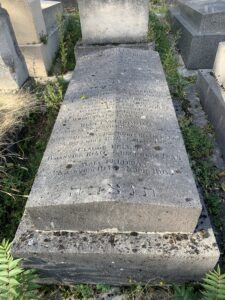
The Weinberg family vault in the 96th division of the Père Lachaise cemetery in Paris.
Our own photo
C. Cousin Alfred
Alfred, who was born on August 29, 1903 in the 11th district of Paris was the son of Isaïe Fernand, so was “our” Alfred’s first cousin. We do not know if the two Alfreds saw each other regularly, but having found some information about him, we thought it would be interesting to include it with a view to a more in-depth study of the families. This strikes us as being quite important, given that they both had the same first name and one could easily get their biographical details mixed up.
On January 30, 1934, in Strasbourg, Alfred married Simone Bicard, a local Jewish girl. At the same time, according to the newspaper Die Neue Welt, the mouthpiece of the Communist Party in Alsace, Alfred donated 200 francs to the poor relief fund. As far as we know, the couple had no children.
Like his father before him, Alfred was a shirtmaker and store keeper. According to legal publications in the French Commercial Archives dated February 10, 1941, he and four other people registered a limited liability company called “Chemiserie-Chapellerie Fernand,” specializing in “the manufacture and sale of shirts and hats.” Its address is listed as 55, rue du Président Wilson in Levallois-Perret, in the Hauts-de-Seine department of France, which was also Alfred’s home address at the time. Alfred invested 45,000 francs in the company, which made him the main shareholder. The share capital was set at 100,000 francs, divided into 100 shares of 1,000 francs each: Alfred therefore owned 45 of them. However, the report states that Mr. Louis Dalibert was to be the sole manager of the company, with full powers to act on its behalf.
French Commercial Archives, February 10, 1941
Of the four people involved in the company, two (Dalibert and Sorbiers de la Tourasse) had surnames that did not sound Jewish. At that time, in the occupied zone, the “Aryanization” of Jewish companies was already underway, having started in May 1940[12]. A man with a Jewish-sounding name such as Feldman could not possibly run the company! Also, the company was named “Fernand”, which was Alfred’s father’s first name. We imagine therefore, although we can’t be sure, that he also worked there.
This Alfred died on November 30, 1992 in Genevilliers, in the Hauts-de-Seine department of France.
II. ALFRED FROM 1910 TO 1939
“Our” Alfred was born on December 16, 1910 at 9, rue Erard in the 12th district of Paris. Given that there was no hospital at that address, he may have been born at a midwife’s home. Three days later, his uncle Fernand registered his birth at the town hall in the 12th district.
We have no further information about Alfred’s childhood and adolescence, sadly, nor about which school(s) he attended[13]. The next trace we found of him was in 1929, by which time he was 18 years old: on January 28 of that year he began his national service in the Navy, in which he served until January 1932.
On September 6, 1931, while he was a sailor on a ship called the Bearn, based in Toulon, in the Var department of France, he legally acknowledged that he was the father of a child born on September 9, 1930, in the 12th district of Paris. The child’s mother was Marie-Louise Hellegouarch, and the child was registered as Gilbert Hellegouarch. This birth remains a mystery, because after that, there is no mention of this son born out of wedlock in any of the records relating to Alfred.
The deed in which Alfred acknowledged that he was Gilbert Hellegouarch’s father, dated September 5, 1931,
Toulon civil register
Alfred’s employment record gives us an insight into his professional activities in the 1930s: he was a laborer at 14, rue Amelot in early 1932, unemployed from February 1932 to July 1933, a drill operator for the Ferodet company at 23, rue du Général Brunet in the 19th district of Paris from July 1933 to December 1934, a laborer at the Walton and Place paper factory at 15-17, rue David d’Angers in the 19th district of Paris from December 1934 to April 1936. Until 1937, therefore, he was an unskilled laborer with no steady job.
STCRP (Paris region public transport corporation) archives
On July 15, 1933, Alfred married a typist named Céline Suzanne Schmotterer[14], in the 19th district of Paris, where she lived. He was still living with his parents at 34 rue Amelot at the time. Sometime later, although we do not know when exactly, the couple moved to 78 rue Julien Lacroix in the 20th district of Paris.
Alfred Feldman and Céline Schmotterer’s marriage certificate dated July 15, 1933, in the 19th district of Paris
Paris civil status register (online)
78, rue Julien Lacroix in the 20th district of Paris,
Our own photo
We have a record of the aptitude tests that Alfred had to take on March 8, 1937, in order to work for the STCRP (Société des Transports en Commun de la Région Parisienne, the Paris region public transport corporation)[15]. A psychometric assessment found him fit for work. He joined the company as a trainee on April 14th, at which time he was living at 88, rue de Crimée[16].
Records from the STCRP archives
On April 19, 1938, he became a fulltime bus conductor and was assigned to the Lagny bus terminal[17].
III. THE WAR
Alfred Feldman was called up on August 28, 1939, but unfortunately there are no records of what he did during his time in the military. He was demobilized on September 11, 1940, but did not go back to work for the STCRP: early on in the war, as a private company operating a public bus service, its network was scaled down and it only ran gas-powered buses and trolleybuses. The Paris subway, meanwhile, which was operated by the CMP (Compagnie du chemin de fer métropolitain de Paris, or Paris Metropolitan Railway Company), saw an increase in passenger traffic. The STCRP was scrupulous in applying the Vichy regime’s rules: as of October 1940, all employees had to sign a sworn agreement to the effect that, to be eligible to work for the company, they were not Jews, Communists or Freemasons; they had been French from birth and they undertook not to spread subversive propaganda[18]. Alfred’s service record states, somewhat disingenuously, that on January 1, 1941, he was “placed on special leave of absence”! He eventually resigned on May 9, 1941, and from June 3, 1941 to December 8, 1942, he worked for the Société française d’articles de penderie (French clothing company) at 104-106, rue Oberkampf.
In April 1942, at the behest of Gauleiter Fritz Sauckel, the Vichy regime introduced a scheme called La Relève (the Relief) in order to meet Nazi Germany’s need for labor. This was to be in exchange for the release of French prisoners of war. This proved rather unsuccessful, however, (only around 30,000 men of the 250,000 forecast went to work in Germany between April and August), so a “relève par requisition” (“relief by requisition”) policy was introduced in early September: Alfred was thus sent to Germany as a “requisitioned worker” in December 1942. He spent a year working as a cutting machine operator at the Farben in Industrie Artiengesellchaft factory in Ludwigshafen, Germany. Records from this period state that he was a French citizen and a Catholic, so it is safe to assume that the German authorities were not aware that he was Jewish. He did not stay there long, however, as he was permanently discharged due to a hernia and blood poisoning. He was sent back to France on January 27, 1943.
Victims of Contemporary Conflicts Archives Division of the Ministry of Defense Historical Service, ref. 27-P-3394- old folder no. 7
He moved back in with his wife at 78, rue Julien Lacroix. A Prefecture record from 1948 states that he then began working for the PTT, the French post, telegraph and telephone service, at the Gare de l’Est station in Paris. This record also gives rise to some confusion, however, which we have unable to resolve: it states that on March 23, 1943, the German authorities arrested him at work on grounds of his “race”. It goes on to say that he was then interned in Drancy and deported to Germany!
General Intelligence Department record.
Paris Police archives
There are a number of discrepancies in this report: he was in fact interned in Drancy after being arrested on July 27, 1944. Might he have been released (and if so why) after that first arrest? If so, it would mean that he was arrested three times: in March ’43, in May ’44 and again in July ’44! We also know that when he was arrested in May 1944, he was working as a driver for the STUR (Société de transports urbains et ruraux, or Urban and Rural Transport Company) based at 156 rue de Vaugirard in the 15th district of Paris.
On May 28, 1944, he was arrested and detained in the Santé prison in Paris for breaching the rationing legislation[19]. After being released provisionally on July 19, he was arrested again on July 27 and handed over to Police Commissioner Permilleux’s brigade, which was part of the Jewish department of the police[20].
Detention records dated July 21 and July 27, 1944,
Paris Police Archives
Alfred was interned in Drancy on July 29[21], and deported to Auschwitz on Convoy 77 on July 31, 1944
Shoah Memorial archivesOn October 13, 1944, Alfred’s wife wrote to the French Social Welfare Department asking if they had any information about what had happened to her husband since he was deported on July 31, 1944. The, which did not arrive until December, told her nothing other than that “most of the Jewish deportees were sent to camps in Upper Silesia and the Protectorate”.
Céline Feldman’s letter dated October 13, 1949,
Victims of Contemporary Conflicts Archives Division of the Ministry of Defense Historical Service, ref. 27-P-3394, old folder no.13
We do not know when Alfred left Auschwitz for Buchenwald, but he was probably evacuated in January and, along with many other internees, forced to go on the “death marches”. While in Buchenwald, he was assigned to block 49 in the smaller camp. In February, he was transferred to Gross Rosen. A record from the ITS in Bad Arolsen reveals that the camp authorities referred to him as a “mischling”, meaning a “half-breed” in Nazi terminology, a rather vague term often translated as a “half-Jew”.
This brings us to an important point about which we have very little information: whether Alfred Feldman was Jewish or not. Apart from records dating from the time of the German Occupation, there is nothing on this subject, in particular in Alfred’s parents’ application for French citizenship. However, the family members’ first names and surnames leave no doubt as to their Jewish roots[22]. We also known that Simone Bicard, “cousin” Alfred’s wife) came from Jewish family in Alsace. The Nazi’s use of the term mischling would suggest that only one of Alfred’s parents was Jewish, but we assume that both were (although we have no evidence of their actual beliefs or whether or not they were practicing Jews). In all of the records we have, Alfred is described as a Catholic. Was he deemed to be a “half-Jew” because his wife was not Jewish? In 1944, the Nazis were determined to fill the deportation trains, and the subtle differences in their racial criteria earlier in the war had become increasingly unimportant.
Bad Arolsen Archives, ref. Enveloppe-Buchenwald-FELDMANN5846884-recto_1.1.5.3
The next trace of Alfred is on May 26, 1945, when he was in a sanatorium in Metz, in the Moselle department of France. Although he survived his time in the camps, a medical report reveals that he was in a very poor state of health: at 5’6” tall, he weighed only 114 pounds, having lost 37 pounds. The report also says that he had bad teeth, a shadow on his left lung and rheumatism in his joints.
Victims of Contemporary Conflicts Archives Division of the Ministry of Defense Historical Service, ref. 27-P-3394, old folder no. 3
Note the error on the Yad Vashem Memorial website, where it claims he was murdered in the camps!
IV. ALFRED’S LIFE AFTER THE WAR: 1946-1976
Alfred survived for thirty years after having been deported, and thought it would be nice to have some idea of how his life unfolded. But, alas, apart from some information about his professional life, we have almost nothing to go on.
Alfred in 1948.
Photo from the RATP (Parisian Autonomous Transport Administration) archives
In December 1946, he returned to work as a conductor for the CMP (Compagnie du chemin de fer métropolitain de Paris, or Paris Metropolitan Railway Company). As we mentioned earlier, he had resigned in 1941, although we do not know whether he did so of his own volition or as a result of the Vichy regime legislation. This time, he was assigned to the Michelet terminus in Saint-Ouen, in the northern outskirts of Paris. We also know that at the end of the war, for reasons unknown, he was placed in the care of Claudine Schmotterer, his wife’s niece, who was born in 1942, so was a very young woman at the time.
Subsequent medical assessments confirm that he was still suffering from the after-effects of deportation and that his health was deteriorating: between April 1947 and May 1948, he was declared unfit to work as a ticket collector. In December 1950, a further psychometric certificate was even more worrying: he was declared unfit to drive a motor vehicle. Alfred appealed against this decision, which was eventually upheld. A note attached to his employment record lists the accidents that took place during his career.
Records from the STCRP archives
In 1949, Alfred was granted deported person status under common law.
Victims of Contemporary Conflicts Archives Division of the Ministry of Defense Historical Service, ref. 27-P-3394, old file no. 4
Alfred en 1958,
Photo du dossier des archives de la RATP
In 1956, Alfred was transferred to the Hainaut terminal at Porte de Pantin, where he worked until he retired. In the early 1960s, his state of health declined sharply: a fitness assessment declared him unfit for working on moving vehicles, and he was advised to avoid strenuous work and contact with the public. He found it difficult to remain standing. In 1961, he became a facility supervisor at Hainaut. He was awarded the French Railways Medal of Honor in early 1962.
From the RATP archives
Alfred asked to retire on September 1, 1962, but he had to go into hospital with a heart condition, so his retirement date was postponed. He eventually retired on May 21, 1963.
Alfred-en 1963,
Photo from the RATP archives
During this post-war period, was he ever in touch with the son he had acknowledged as his in 1931? We cannot answer this question, but we would like to mention two records nonetheless:
- Céline Schmotterer’s mother died in 1957: we found her death notice, and while all her descendants are mentioned, Gilbert (who was admittedly not her grandson) is not listed, which confirms that he was not a close family member.
- Another record, dating from 1960, lists the dates on which Alfred was arrested and interned. However, what is much more of interest to us is that it mentions, for the first and only time since he was born, his son Gilbert.
From the RATP archives
Alfred Feldman died on May 5, 1976 at the Salpétrière hospital at 47, Boulevard de l’Hôpital in Paris. His address at the time was 4, rue Hector Berlioz (a high-rise low-cost apartment building) in Epinay-sur-Seine, in the Seine-Saint Denis department of France.
Alfred Feldman’s death certificate, dated May 5 1976, in the 13th district of Paris,
Family archives
He is buried in plot 694 TR 1976 in the Pantin cemetery in Paris (63rd division, row 6, grave 35). His widow, Céline Schmotterer outlived him by twenty-five years, and died on July 15, 2001 in Tourcoing, in the Nord department of France, at the age of 91. She is buried with him.
Alfred and Céline Feldman’s grave at the Pantin cemetery in Paris
Our own photos
V. SUMMARY: OUTSTANDING GREY AREAS
- What became of Alfred’s father, Salomon Feldmann, after 1936? When and where did he die and where was he buried? Despite exhaustive searches of all the civil registers of all the districts of Paris, we found nothing, and nor did we find any information in the burial registers of all Parisian cemeteries. Nor did we find any information in the burial registers of any of the cemeteries in and around Paris.
- Since he grew up on rue Amelot in the 11th district of Paris, Alfred must have gone to school locally, but we have been unable to find out where.
- Although we have his military service number, we have been unable to retrieve “Seaman” Alfred Feldman’s service record. This is all the more frustrating as it would no doubt have helped us understand how and when he met Marie-Louise Hellegouarch (we imagine – though have no proof – that he spent some time at the navy base in Lorient). As Gilbert was born in early September 1930, he must have been conceived at the end of 1929… A Christmas or New Year gift?!
- The biggest mystery, of course, is who Gilbert’s father was: his birth certificate states that two different men acknowledged that they were Gilbert’s father, which is both physically impossible and legally impermissible!
Notes & references
[1] Salomon’s name is spelled with two “n”s, while his son’s name only has one.
[2] Another record says that she was born in Craiova on October 20, 1883.
[3] One of the documents in his application for French citizenship states that Salomon had been living in France since April 10, 1909: might he have gone back to Romania to get married?
[4] On July 4, 1916, the French soldiers took the first German line at Dompierre-Becquincourt, Fay and Assevillers. The German troops retreated to their second fortified line at Belloy-en-Santerre. The infantrymen of the 35th army corps and those of the Marching Regiment of the Foreign Legion mounted an assault, bayonets fixed, across open ground. They came under machine gun fire some 300 meters from the German lines. Nevertheless, despite the high number of casualties (900 men were killed, including the American poet Alan Seeger), the French had the upper hand but suffered several counter-attacks. Source: Wikipedia
[5] Her death certificate demonstrates how little information the hospital authorities had, as it gives her date of birth as November 15, 1881, which was in fact her husband’s date of birth! The certificate does not say who her father was, but it does say that her mother’s surname was Roscutipain.
[6] The tomb has not been taken over: it was renewed in 1936, 1940 and 1958.
[7] Application for French citizenship.
[8] He was no doubt the person who encouraged Salomon to come to France and set up home in the 11th district of Paris.
[9] Not to be confused with his first cousin, “our” Alfred.
[10] We know this because Alfred was living there when he was one of the people who registered the birth of his nephew, Alfred.
[11] Dossier 9.446 x 09.
[12] The Vichy government passed the law on the Aryanization of Jewish property on June 22, 1941.
[13] On sait seulement que jusqu’à son service militaire, il vivait au 109, rue Cambronne.
[14] Born on March 1, 1910 in the 19th district of Paris to Eugène François, 42 years old, shoemaker, and Marie Guerre, aged 30, day laborer, living at 88 rue de Crimée. Died in Tourcoing on July 15, 2001.


 Français
Français Polski
Polski